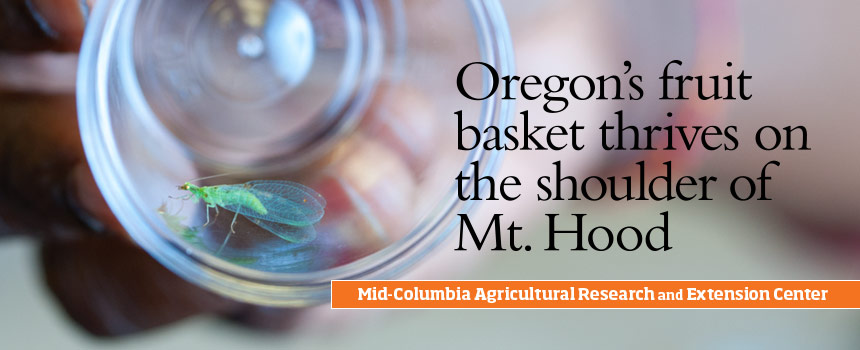On the front line

While we see sweet cherries and pears as delicious fresh foods, insect pests see them as home. But these pests aren’t model tenants. They can bruise and discolor fruit skin and turn fruit flesh mushy. “Consumers expect a high standard of quality, clean produce,” said Peter Shearer, an OSU entomologist who researches integrated pest management. “If not managed properly, even the smallest pests can have a huge impact on growers’ bottom line.”
To battle invasive pests, OSU researchers develop methods to minimize pest impact with less dependence on pesticides. That was just the approach taken about 20 years ago when young codling moth larvae were tunneling into pears and apples and ruining crops all over Oregon. Insecticide sprays in use at the time were broad-spectrum and indiscriminate, killing both the moths and the helpful predators of other problem insects. The result was outbreaks of additional pests, such as pear psylla, an insect that extrudes a liquid that can damage leaf tissue and encourage sooty mold growth in pears.
[caption] Integrated pest management (IPM) is a story of collaboration. Oregon State University scientists across the state unite to tackle some of the most pressing pest issues farmers face today.[/caption]
Integrated pest management (IPM) is a story of collaboration. Oregon State University scientists across the state unite to tackle some of the most pressing pest issues farmers face today.[/caption]
OSU researchers have since developed a much more targeted approach to pest management, using pheromones that disrupt the mating patterns of codling moths but do not interfere with beneficial predatory insects—a practice now widespread across the Pacific Northwest. And research colleagues have found that orchards using a codling moth mating-disruption program generally have greatly reduced levels of pear psylla.
Pesticides were once considered the primary weapon against the Western cherry fruit fly, a speck of a pest that caused headaches for growers for decades. In the past, orchards were sprayed from airplanes with broad-spectrum pesticides to suppress the fly. Using a strategy of integrated pest management, OSU researchers introduced thick bait applied only where needed to kill pesky flies before they can lay eggs. “Insecticide use in the mid-Columbia is way down from historic levels, keeping toxins from contaminating surface water,” said Shearer.
But OSU’s work is far from over. The Pacific Northwest’s tree fruit industry now faces new challenges from two recent foreign invaders: the spotted wing drosophila and the brown marmorated stink bug.
OSU is guiding efforts to squash these pests as a lead institution on two large, federally funded grants from the National Institute of Food and Agriculture. Scientists are helping to design new traps and to pinpoint what and when to spray to protect crops. They are travelling abroad searching for natural enemies that seek out and destroy the pests. “In Hood River, OSU has more than 100 years of researching entomological issues in our orchards and fields,” said Shearer. “That legacy pushes us to finding solutions for new problems. That’s the whole reason why we’re here.”
